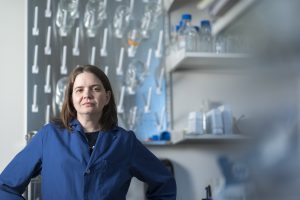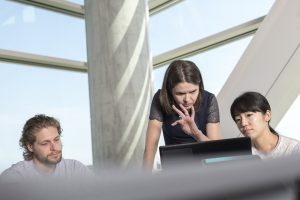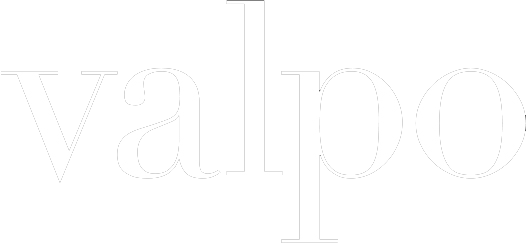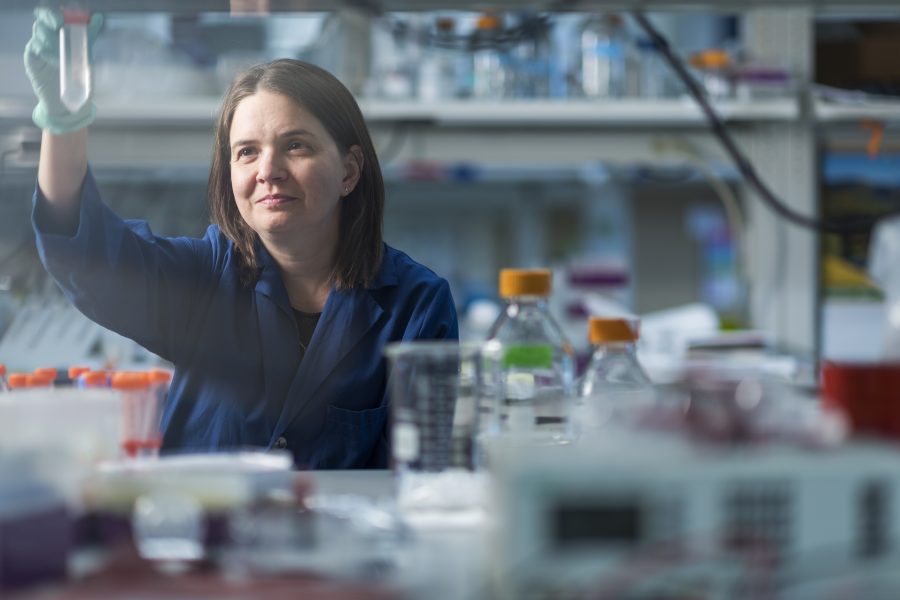Valpo Values Help Pam Kreeger ’00 Fight Cancer
Half of all women diagnosed with ovarian cancer will die within five years. And with intense surgery and multiple rounds of chemotherapy, the treatment plan may be just as tough as the disease. Pam Kreeger ’00 wants to change that.
Pam earned her degree in chemistry from Valparaiso University in 2000 and her Ph.D. in chemical engineering in 2005 from Northwestern University. She then conducted postdoctoral studies in biological engineering at MIT. Now an associate professor of biomedical engineering at the University of Wisconsin in Madison, Wisconsin, it’s in her lab and work in the university’s Carbone Cancer Center where she seeks to improve the lives of women diagnosed with ovarian cancer.
According to the American Cancer Society, ovarian cancer is the fifth-leading cancer killer among women. A woman’s risk of getting ovarian cancer during her lifetime is about 1 in 75.
The field of ovarian cancer research has evolved tremendously during the past decade, Pam says. Scientists have been able to isolate where the cancer originates — which has been a revelation to the cancer community. Originally doctors thought ovarian cancer originated in the ovaries, but new evidence suggests it starts in the fallopian tubes and migrates into the ovaries before spreading throughout the abdomen.
“Most women are diagnosed at this late stage,” Pam says. “We are trying to develop systems in vitro (in a dish) to see how cells in these metastatic tumors are interacting. We are trying to understand what is helping the tumor spread so rapidly and then find a way to stop it.”
Working with funding from an American Cancer Society (ACS) grant, the team has found there is a three-way communication between different cells that may be key.
“If we break this communication, we can slow metastasis down in our models,” Pam says. “This would not be a cure but could slow the disease.”
The hope is that this new approach could lessen the physical toll of treatment for women, while also improving quality of life and prolonging survival.
Pam is quick to identify her engineering background as one key to the team’s success in this new discovery.
“Because we are engineers, we approach problems a little differently than most scientists,” Pam says. “We have developed these systems to mimic the tumor site, but in a controlled way that is not possible in animal models. We then use those systems to pick apart how the cells ‘talk’ and decide what to follow up on.”
A SCIENTIST AND ENGINEER IN THE MAKING
“I remember being a second grader and wanting to be an astronaut,” Pam says. “Space was a big obsession for me.”
While she does not recall when that dream faded, she does remember when she started to consider all the options there were in the STEM (science, technology, engineering, and mathematics) fields — it was during a lab class in middle school.
“I liked math but didn’t want to do business or be a mathematician,” Pam says. “I learned in the lab that I had the patience Cancerand skills to do science. It was later that I realized as a biomedical engineer I could do it all — math, physics, chemistry, and biology.”
While being a scientist was a childhood dream, attending Valpo wasn’t always Pam’s intention. Both her sister (Shelly ’94) and brother (David ’98) are Valpo graduates — a fact that almost deterred her from even applying. But she eventually acquiesced to family wishes to at least apply and take a campus visit. And seeing campus was all it took.
“I really liked the atmosphere,” Pam says. “I knew I was going into science. The things I thought were appealing at a larger university were still possible at Valpo — namely being involved in undergraduate research. I really liked the smaller environment. I had access to labs and professors from day one.”
It was in those labs, focused on experiential learning, that Pam felt at home. “The lab portion of the classes are common (from school to school),” Pam says. “But at Valpo, you are the one running the experiment and running the tests to get the results. We were trained by the professors rather than teaching assistants, which I think led to more solid training.”
One of those professors was Tom Goyne, Ph.D., associate professor of chemistry. “As a student, Pam was very quick to solve difficult problems,” Professor Goyne says, “and she found it challenging to wait for others (like me) to catch up with her.”

Another advantage of attending Valpo, Pam says, was the flexibility to take a variety of classes outside her major. Pam explored a variety of career options, including research, secondary education, and pre-medicine. In addition, she pursued her interests, completing a minor in history.
“I must say Valpo was very tolerant of me,” she says. “That kind of liberal arts education takes additional work, but it was very valuable for me.”
Valpo’s liberal arts foundation equipped Pam with critical-thinking skills and developed her abilities as a well-rounded scientist. And while she graduated with a degree in chemistry, Pam’s career in engineering also started at Valpo.
“The summer before my senior year, I realized I wanted to be an engineer, which I hadn’t majored in,” she says. “The engineering professors were very supportive of someone trying to throw themselves in the deep end as I prepared for graduate school.” Based on their experiences advising Pam and other students, faculty from the College of Engineering and the College of Arts and Sciences developed a minor in engineering for students interested in this cross-training.
Chandra West ’00 Adams was Pam’s frequent lab partner and saw her in action firsthand. “It was evident freshman year that Pam would be a success in science,” says Chandra, who attended law school after Valpo and is now an intellectual property attorney in Boston. “From our first lab in freshman chemistry, it was clear that she has incredible attention to detail, is highly organized and methodical in her approach to science, and, most importantly, knows how to pose a hypothesis and make sense of the answers. Her drive and determination to succeed were evident throughout our four years at Valpo and clearly remained intact through her post-graduate studies.”
ART AND SCIENCE OF TEACHING
Pam now works to bring a little bit of that Valpo spirit to Madison, Wisconsin.
“There are a lot of different elements from my undergrad days that I bring to my work at Wisconsin,” Pam says.
While Wisconsin doesn’t have an honor code like Valpo, Pam said she still lives by it and instills those same values of character and integrity in her current students.
Pam recalled one time at Valpo she was feeling a little overwhelmed with all of her course work. But due to the generosity of one of her chemistry professors, she was able to make it through.
“I still had to do all of the work, but I worked with my professor to develop a new timeline that worked for us both,” she says.
Providing flexibility and treating students as individuals is something Pam continues to do. She recently had one student who regularly held herself to ridiculously high standards, Pam says. This student, just as Pam had been, was overwhelmed and needed a guiding hand. Pam was happy to provide that guidance, and her student went on to complete her studies and graduate with honors.
Chandra, for one, recognized Pam had the makings of a professor during their days at Valpo.
“Pam’s academic focus was incredible, and she was able to translate her comprehension of the classroom concepts into the lab,” Chandra says. “She has an innate ability to understand something complex and distill it down to terms anyone can understand.”
TEACHING THE NEXT GENERATION
The key to bringing more young students into the sciences is to get the students early and make the learning hands-on and experiential.
“The sciences and engineering are not just reading and knowing facts,” Pam says. “It’s about problem solving.”
To help ensure that young girls consider the STEM path, it is important to surround them with other girls and women who can be mentors and peers. The reason is simple, Pam says. “The key to success for me was having other women with me. It’s very difficult to be the only one of anything in the room. And it becomes more difficult when you multiply that by all of the classes you have to take.”
While other engineering fields are lucky to see one in five students be female, Pam notes that bioengineering is close to gender parity, and half of her research team is composed of female students.
As Pam builds her team, she hasn’t forgotten her Valpo roots. In fact, two students who have worked in her lab at Wisconsin were Valpo undergrads at the time.
One such student was Jordan Otto ’15, who is now at graduate school at Harvard in the Dana-Farber Cancer Institute.
“As an undergraduate without prior biological research experience, her mentorship and direction were very influential on my perception of academic research and solidified my decision to Vattend graduate school after graduating from Valpo,” Jordan says. “Spending a summer in the Kreeger Lab gave me valuable technical skills as well as insight into the workings of an academic research lab. I am very grateful to Dr. Kreeger for sharing her expertise, mentorship, and resources with me during this time.”

“ THAT CONNECTION TO PATIENTS AND THEIR FAMILIES HAS HELPED TO KEEP MY LAB FOCUSED THROUGH THE UPS AND DOWNS OF DOING RESEARCH.”
Lauren Prusinski ’13 partly owes the fact she is pursuing a combined M.D./Ph.D. from the Medical College of Georgia at Augusta University to her time in Pam’s lab.
“While pursuing my first major in biochemistry at Valpo, I knew that I excelled in ‘textbook science,’ ” Lauren says. “I had not yet determined whether I would want to pursue medical school, graduate school, or another vocation following graduation. It was by complete whim I met Pam after a Valpo chemistry department event, when she encouraged me to contact her about spending some time in her lab the following summer.”
Lauren spent multiple summers working and learning in Pam’s lab.
“We discussed often her educational and research backgrounds, and it was clear that she worked hard and intelligently to achieve what she had early in her career,” Lauren says. “As a successful female in science, let alone biomedical engineering, Pam demonstrated her desire to push her students to achieve more — not just by working harder, but by working smarter and learning how to be productive and independent.”
Just as she was given autonomy and great responsibility as an undergrad at Valpo, Pam places the same level of accountability on her students. Pam meets with her students each week to discuss the results of the week’s experiments. She first asks the graduate student and the lab assistant specific questions about the data to ensure not only the graduate student understands each result, but the undergraduate intern, as well. This provides clear direction to the intern to not just tag along during the summer research, but to truly understand and apply the scientific method. Summer interns often plan and perform their own experiments.
“Pam made me feel like she was interested in my success, even as a young undergraduate trainee who was only there for the summer semesters,” Lauren says.
Pam continues to give back to her alma mater in other ways as well, Professor Goyne says.
“Pam has come back to campus to talk with current students doing scientific research,” Professor Goyne says. “In addition to talking about her research, she has shared her reflections on what it takes to combine the roles of mother and research director. Many of our female students are unsure about the difficulty of combining these two roles, and Pam is a wonderful example for them.”
CONTINUING THE PUSH TO IMPROVE WOMEN’S HEALTH
Just as she wasn’t always sure she would attend Valpo, Pam didn’t set out to find a cure for ovarian cancer. Her post-doctorate work was on colon cancer. However, during that time, a good friend of her sister died of ovarian cancer. The scientist and engineer in Pam wanted to know more about this disease.
“I looked into this and realized how little was known about ovarian cancer and how little was being done,” Pam says.
So Pam has made studying ovarian cancer the focus of her work at UW. She has amassed quite an impressive cadre of awards and grants. One of her more prestigious awards was being named a New Innovator by the National Institutes of Health (NIH). But perhaps the awards that mean the most to her have come from the ACS. She was awarded an ACS postdoctoral fellowship in 2008 and was named an ACS research scholar in 2013.
“The American Cancer Society  grant really got my cancer work going,” Pam says. “It’s the one I’m most proud of, because the funding is coming from donors, from things like the Relay for Life. That connection to patients and their families has helped to keep my lab focused through the ups and downs of doing research.”
grant really got my cancer work going,” Pam says. “It’s the one I’m most proud of, because the funding is coming from donors, from things like the Relay for Life. That connection to patients and their families has helped to keep my lab focused through the ups and downs of doing research.”
Just as she has her entire academic, teaching, and research career, Pam will continue her scientific journey developing answers to difficult questions.

